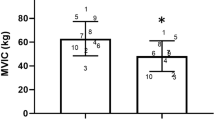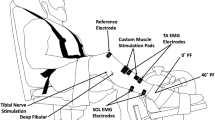Abstract
Purpose
The purpose of the present study was to examine the fatigue-related patterns of responses for electromyography (EMG), mechanomyography (MMG), and force during a sustained, submaximal isometric leg extension muscle action anchored at RPE = 5.
Methods
Ten women (23.1 ± 2.3 year) performed two, maximal voluntary isometric contractions (MVIC) prior to and following an isometric muscle action that was sustained at RPE = 5 (OMNI-RES) for a maximal time-limit of 5 min or until RPE = 5 could not be maintained (actual time-limit). EMG amplitude (AMP), EMG mean power frequency (MPF), MMG AMP, MMG MPF, and force values were determined every 5% of the actual or maximal time-limit. Regression analyses were used to examine the neuromuscular parameters and force vs. time relationships.
Results
The pretest MVIC (46.9 ± 8.9 kg) was significantly (p = 0.003; d = 1.8) greater than posttest (36.4 ± 5.3 kg) MVIC. The actual time-limit was 180 ± 90.9 s (range 84.8–300 s). The percent decline in force production during the sustained isometric muscle action was 34.7 ± 17.1%, and there was a significant negative, quadratic force vs. time relationship (p < 0.001; R = − 0.983). There was a significant positive, quadratic MMG AMP vs. time relationship (p < 0.001; R = 0.852), but no significant (p > 0.05) relationships for EMG AMP, EMG MPF, or MMG MPF vs. time.
Conclusions
The current findings indicated that it was necessary to reduce force to maintain RPE = 5. The neuromuscular and force responses supported the RPE clamp model and suggested that force was initially regulated by anticipatory feedforward mechanisms and then altered by afferent feedback.



Similar content being viewed by others
Abbreviations
- AMP:
-
Amplitude
- EMG:
-
Electromyography
- MMG:
-
Mechanomyography
- MPF:
-
Mean power frequency
- MVIC:
-
Maximal voluntary isometric contraction
- OMNI-RES:
-
Omni-resistance training scale
- RPE:
-
Rating of perceived exertion
References
Alegre LM, Aguado X, Rojas-Martín D, Martín-García M, Ara I, Csapo R (2015) Load-controlled moderate and high-intensity resistance training programs provoke similar strength gains in young women. Muscle Nerve 51(1):92–101
Amann M, Venturelli M, Ives SJ, McDaniel J, Layec G, Rossman MJ, Richardson RS (2013) Peripheral fatigue limits endurance exercise via a sensory feedback-mediated reduction in spinal motoneuronal output. J Appl Physiol 115:355–364
Astokorki AHY, Mauger AR (2017) Tolerance of exercise-induced pain at a fixed rating of perceived exertion predicts time trial cycling performance. Scand J Med Sci Sports 27(3):309–317
Beck T, Housh T, Johnson G, Weir J, Cramer J, Coburn J, Malek M (2004) Mechanomyographic amplitude and mean power frequency versus torque relationships during isokinetic and isometric muscle actions of the biceps brachii. J Electromyogr Kinesiol 14(5):555–564
Beck TW, Housh TJ, Cramer JT, Weir JP, Johnson GO, Coburn JW, Malek MH, Mielke M (2005) Mechanomyographic amplitude and frequency responses during dynamic muscle actions:a comprehensive review. Biomed Eng Online 4(1):67
Bigland-Ritchie B, Woods JJ (1984) Changes in muscle contractile properties and neural control during human muscular fatigue. Muscle Nerve 7(9):691–699
Borg G (1970) Perceived exertion as an indicator or somatic stress. Scand J Rehabil Med 2:92–98
Borg G (1982) Psychophysical bases of perceived exertion. Med Sci Sports Exerc 14:377–381
Broxterman RM, Hureau TJ, Layec G, Morgan DE, Bledsoe AD, Jessop JE, Amann M, Richardson RS (2018) Influence of group III/IV muscle afferents on small muscle mass exercise performance: a bioenergetics perspective. J Physiol 596(12):2301–2314
Camic CL, Housh TJ, Zuniga JM, Hendrix CR, Bergstrom HC, Traylor DA, Schmidt RJ, Johnson GO (2013) Electromyographic and mechanomyographic responses across repeated maximal isometric and concentric muscle actions of the leg extensors. J Electromyogr Kinesiol 23(2):342–348
Cochrane-Snyman KC, Housh TJ, Jenkins ND, Bergstrom HC, Smith CM, Hill EC, Johnson GO, Schmidt RJ, Cramer JT (2015) Electromyographic, mechanomyographic, and metabolic responses during cycle ergometry at a constant rating of perceived exertion. Appl Physiol Nutr Metab 40(11):1178–1185
Cochrane-Snyman KC, Housh TJ, Smith CM, Hill EC, Jenkins NDM, Schmidt RJ, Johnson GO (2016) Inter-individual variability in the patterns of responses for electromyography and mechanomyography during cycle ergometry using an RPE-clamp model. Eur J Appl Physiol 116(9):1639–1649
Cotter JA, Garver MJ, Dinyer TK, Fairman CM, Focht BC (2017) Ratings of perceived exertion during acute resistance exercise performed at imposed and self-selected loads in recreationally trained women. J Strength Cond Res 31(8):2313–2318
Ebenbichler GR, Kollmitzer J, Glöckler L, Bochdansky T, Kopf A, Fialka V (1998) The role of the biarticular agonist and cocontracting antagonist pair in isometric muscle fatigue. Muscle Nerve 21(12):1706–1713
Edwards RH (1981) Human muscle fatigue: physiological mechanisms. Pitman Medical, London (Ciba Foundation symposium 82), pp 1–18
Fairman CM, Zourdos MC, Helms ER, Focht BC (2017) A scientific rationale to improve resistance training prescription in exercise oncology. Sports Med 47(8):1457–1465
Farina D, Merletti R (2000) Comparison of algorithms for estimation of EMG variables during voluntary isometric contractions. J Electromyogr Kinesiol 10(5):337–349
Farina D, Merletti R, Enoka R (2004) The extraction of neural strategies from the surface EMG. J Appl Physiol 96(4):1486–1495
Farina D, Merletti R, Enoka R (2014) The extraction of neural strategies from the surface EMG: an update. J Appl Physiol 117(11):1215–1230
Flood TR, Waldron M, Jeffries O (2017) Oral l-menthol reduces thermal sensation, increases work-rate and extends time to exhaustion, in the heat at a fixed rating of perceived exertion. Eur J Appl Physiol 117(7):1501–1512
Gearhart RE, Goss FL, Lagally KM, Jakicic JM, Gallagher J, Robertson RJ (2001) Standardized scaling procedures for rating perceived exertion during resistance exercise. J Strength Cond Res 15(3):320–325
Gibson ASC, Noakes TD (2004) Evidence for complex system integration and dynamic neural regulation of skeletal muscle recruitment during exercise in humans. Br J Sports Med 38(6):797–806
Hermens H, Freriks B, Merletti R, Stegeman D, Blok J, Rau G, Disselhorst-Klug C, Hägg G (1999) European recommendations for surface electromyography. Roessingh Research and Development, Enschede
Jensen BR, Jorgensen K, Sjøgaard G (1994) The effect of prolonged isometric contractions on muscle fluid balance. Eur J Appl Physiol 69:439–444
Keller JL, Housh TJ, Smith CM, Hill EC, Schmidt RJ, Johnson GO (2017) Sex-related differences in the accuracy of estimating target force using percentages of maximal voluntary isometric contractions versus ratings of perceived exertion during isometric muscle actions. J Strength Cond Res (Publish-Ahead-of-Print)
Lagally KM, Robertson RJ (2006) Construct validity of the OMNI resistance exercise scale. J Strength Cond Res 20(2):252
Lander PJ, Butterly RJ, Edwards AM (2009) Self-paced exercise is less physically challenging than enforced constant pace exercise of the same intensity: influence of complex central metabolic control. Br J Sports Med 43(10):789–795
Lindstrom L, Magnussin R, Petersen I (1970) Muscular fatigue and action potential conduction velocity changes studied with frequency analysis of EMG signals. Electromyography 10(4):341–356
Marcora S (2009) Perception of effort during exercise is independent of afferent feedback from skeletal muscles, heart, and lungs. J Appl Physiol 106:2060–2062
Maughan RJ, Harmon M, Leiper JB, Sale D, Delman A (1986) Endurance capacity of untrained males and females in isometric and dynamic muscular contractions. Eur J Appl Physiol Occup Physiol 55(4):395–400
McCloskey DI (1978) Kinesthetic sensibility. Physio Rev 58:763–820
Morrin NM, Stone MR, Swaine IL, Henderson KJ (2018) The use of the CR-10 scale to allow self-regulation of isometric exercise intensity in pre-hypertensive and hypertensive participants. Eur J Appl Physiol 118(2):339–347
Noakes T (2012) Fatigue is a brain-derived emotion that regulates the exercise behavior to ensure the protection of whole body homeostasis. Front Physiol 3:82
Noakes TD, Gibson ASC, Lambert EV (2004) From catastrophe to complexity: a novel model of integrative central neural regulation of effort and fatigue during exercise in humans. Br J Sports Med 38(4):511–514
Noble BJ, Robertson RJ (1996) Perceived exertion. Human Kinetics, Champagne
Orizio C, Gobbo M, Diemont B, Esposito F, Veicsteinas A (2003) The surface mechanomyogram as a tool to describe the influence of fatigue on biceps brachii motor unit activation strategy. Historical basis and novel evidence. Eur J Appl Physiol 90(3–4):326–336
Pescatello LS, Arena R, Riebe D, Thompson PD (2013) ACSM’s guidelines for exercise testing and prescription 9th edition. Lippincott Williams and Wilkins, Philadelphia
Ratamass NA, Alvar BA, Evetoch TK, Housh TJ, Kibler B, Kraemer WJ, Triplett T (2009) Progression models in resistance training for healthy adults. Med Sci Sports Exerc 41:687–708
Robertson RJ (2004) Perceived Exertion for practitioners: rating effort with the OMNI picture system. Human Kinetics, Champaign
Robertson RJ, Goss FL, Rutkowski J, Lenz B, Dixon C, Timmer J, Frazee K, Dube J, Andreacci J (2003) Concurrent validation of the OMNI perceived exertion scale for resistance exercise. Med Sci Sports Exerc 35(2):333–341
Sjogaard G, Saltin B (1982) Extra-and intracellular water spaces in muscles of man at rest and with dynamic exercise. Am J Physiol Regul Integr Comp 243(3):R271–R280
Smith CM, Housh TJ, Herda TJ, Zuniga JM, Camic CL, Bergstrom HC, Smith DB, Weir JP, Hill EC, Cochrane KC, Jenkins ND (2016) Time course of changes in neuromuscular parameters during sustained isometric muscle actions. J Strength Cond Res 30(10):2697–2702
Tucker R (2009) The anticipatory regulation of performance: the physiological basis for pacing strategies and the development of a perception-based model for exercise performance. B J Sports Med 43(6):392–400
Tucker R, Marle T, Lambert EV, Noakes TD (2006) The rate of heat storage mediates an anticipatory reduction in exercise intensity during cycling at a fixed rating of perceived exertion. J Physiol 574(3):905–915
Vargas-Terrones M, Barakat R, Santacruz B, Fernandez-Buhigas I, Mottola MF (2018) Physical exercise programme during pregnancy decreases perinatal depression risk: a randomised controlled trial. Br J Sports Med 13:bjsports-2017
Weir JP, Beck TW, Cramer JT, Housh TJ (2006) Is fatigue all in your head? A critical review of the central governor model. Br J Sports Med 40(7):573–586
Yao W, Fuglevand RJ, Enoka RM (2000) Motor-unit synchronization increases EMG amplitude and decreases force steadiness of simulated contractions. J Neurophysiol 83(1):441–452
Acknowledgements
In addition, we would like to thank all the individuals who volunteered for our study.
Author information
Authors and Affiliations
Contributions
All authors conceived and designed the research. JLK, ECH, and CMS contributed to the data collection and analysis. JLK and TJH wrote the manuscript. ECH, CMS, RJS, and GOJ contributed edits, feedback, and suggestions for the manuscript. All authors read and approved the manuscript.
Corresponding author
Ethics declarations
Conflict of interest
All authors declare that they have no conflicts of interest.
Additional information
Communicated by William J. Kraemer.
Rights and permissions
About this article
Cite this article
Keller, J.L., Housh, T.J., Hill, E.C. et al. Neuromuscular responses of recreationally active women during a sustained, submaximal isometric leg extension muscle action at a constant perception of effort. Eur J Appl Physiol 118, 2499–2508 (2018). https://doi.org/10.1007/s00421-018-3976-y
Received:
Accepted:
Published:
Issue Date:
DOI: https://doi.org/10.1007/s00421-018-3976-y




